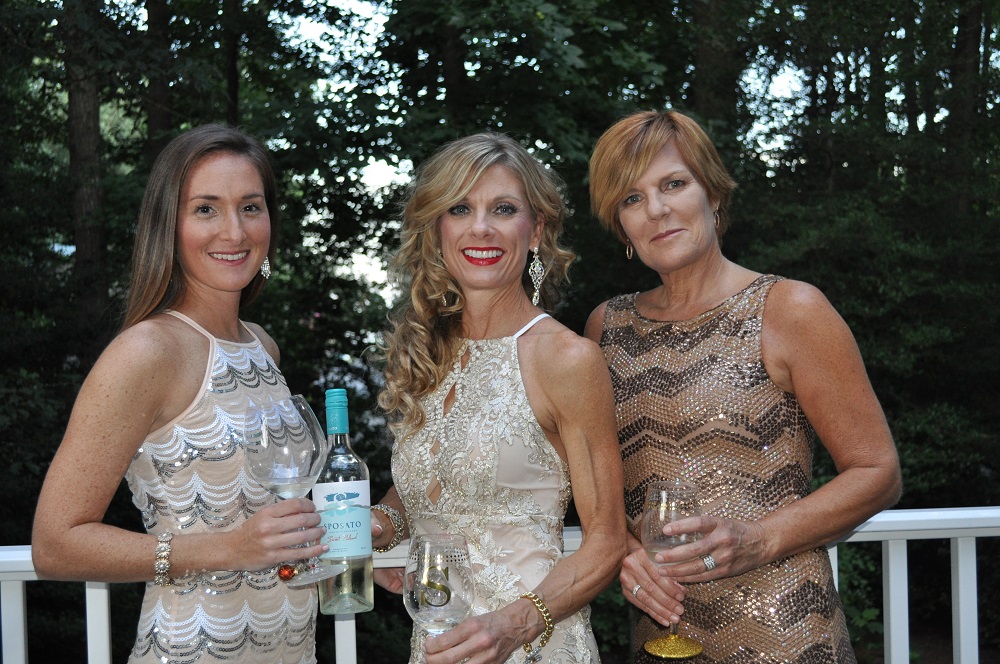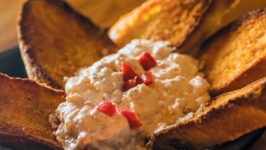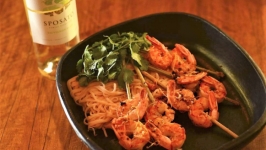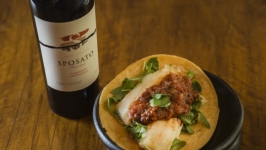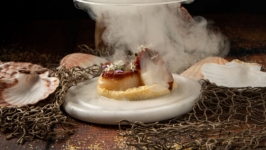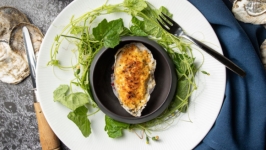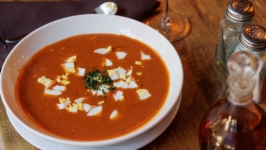Perfect Pairings: A Feast of Wine and Fishes
Normally, when a chef and a vintner do a tasting they are in it for the long haul. It is serious business, and usually in the middle of their workday. At most one-ounce pours, a swirl, a deep sniff, and then you hold the liquid in your mouth for the palate to do its work and separate into all the flavor components. Finally, you let the liquid trickle down your throat and dump the extra in a bucket.
But Karen Sposato writes her own rules. We are in her home doing a complete tasting of the wines the Sposato family have developed from the Mendoza Valley vineyard in Argentina, where they broke ground in 2012. Their vineyard is producing wines of such depth and complexity that they belie the young age of the vintners, and their entrée into the world of winemaking. This is wine worth drinking, and we are not going to waste even one drop in a dump bucket.
It is mid-morning, just after the Thursday spin class Karen teaches and we are stretched out on her comfy family room couches. She and I are new friends, just getting to know one another. By happy accident, we found ourselves working together to plan a wine dinner for the holidays; each one of Sposato Family Vineyards’ wines paired with a seafood dish. We will work together to create an updated chef’s interpretation of the feast of the seven fishes, matching each course with a different Sposato wine from her list. We are definitely not going anywhere anytime soon.
We start with the Frizzante, which like Karen, bubbles and bounces on your palate with hints of tropical fruits and sunshine. After one glass, I am pretty sure I am going to need a ride home. After two glasses, I’m pretty sure I should just move in and live with her forever.
Then comes the Sauvignon Blanc, and I am hooked. Notes of grapefruit and lemongrass with just a hint of orange blossom in my mouth and my little chef’s mind is swirling and purring with ideas, “I can see this one paired with a Vietnamese dish, maybe a lemongrass skewered shrimp with nouc mam? How about we do a trip around the world, with all the sexy cuisines? Each course a different country as well as a different wine?”
Karen is enthusiastic as she pours the Chardonnay; we swirl and sip the peaches and apples. “I want to honor women somehow,” she muses. “Can you design the dishes to do that? Make it an acknowledgement to the culinary and cultural traditions of women, without losing what makes the dishes familiar?”
I sip some more Chardonnay that smells so good I want to take a bath in it. “Tell me about why you chose Argentina?” I ask.
Karen puts on her vintner hat for a moment, “Well the land and the soil to start, because that was the skill set our family landscape business brought into wine making,” she begins. “We know how to make things grow and thrive. Lujan de Cuyo is the wine region of Argentina where the water flows down from the Andes Mountains with the purest power of the earth. The water, weather and soil are simply perfect if you want to grow grapes for creating complex and beautiful flavors. While we were looking for land I fell in love with the strong and soft-spoken women of the Mendoza Valley and their weekly family ‘asados’ - when the families meet together to cook in the huge kitchens. The women present the food and share the warmth of the feast. The women welcomed me into their kitchens, and the winemaking families welcomed us into their town and their culture, while accepting our differences. I love being there.”
As she pours the Bonarda, Karen has an idea. “How about we invite all our women friends and make it a party? Just like the asados!” By the time we have reached the bottom of our glasses of Bonarda, with its distinctive notes of blackberry and figs, she has her address book out and is making a list.
Halfway through the tasting I have reached the giggling stage. I am just managing to keep tasting notes. Not Karen, she is bouncing around the room like she is still teaching spin. I expect her to hand me some weights in a minute to do a few Pilates exercises. I am also pretty sure that with another sip of the Malbec Reserve I will simply melt through the floor. It tastes like velvet, if velvet were a flavor. When I close my eyes, I am somewhere in the sun, instead of a frosty winter morning on the Delmarva Peninsula. I can smell the wood smoke and the cloves from the glass; it is so redolent it is like an olfactory mirage. It smells like happiness if that were a flavor too. Liquid velvet happiness, I think. I note the sentiments carefully in my notebook, as if it will still be profound tomorrow.
We move on to the Cabernet and its deep rich chocolate finish, with plum and currants that just linger on your tongue. It tastes like a mole I used to make in Oaxaca with smoked chiles, cinnamon sticks, almonds and unsweetened Mexican chocolate from the Mayans. I am sipping the different flavor components, thinking of nothing but the food I want to create. Karen, on the other hand, has finished a guest list, designed an invitation, and is getting ready to send it out. I am dreaming about cuisines of the sun and she is coming up with names for the party (we settle on Bubbles and Bling), has picked dates, and is carefully crafting the list of the women she wants to bring together. I am searching for the nuance of spice and she is getting it organized and done; like strong and capable women who make a difference have done since the beginning of time.
Party day arrives and I have cooked my little chef’s heart out. Each dish had been reinterpreted many times, but the final offerings were still a feast of the seven fishes paired with seven Sposato wines. Each mouthful was a journey around the world exploring the cuisines of the sun. I wanted each dish to be simple, to allow the nuances of spice, tradition and flavors of the wine pairings to come forward. Each dish also had to be representative of a region in the world where the culinary tradition is rooted in the commonality of strong women who feed their families with passion and love. Karen had invited women who, in her words, represented the cultures of different diverse experiences within our community. Bright and beautiful women gathered for a reinterpreted all female asado, where they sparkled just like their hostess. We feasted, we drank, we laughed and we shared stories. And while we may have come together as strangers, we surely left as friends.


